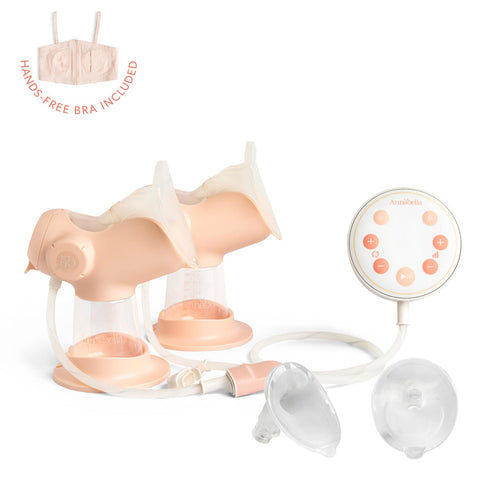Embarking on the journey of breastfeeding and pumping as a new mother is both exciting and challenging. From navigating the intricacies of finding the right flange size to grappling with insufficient milk production, the path to successful pumping can be riddled with obstacles. However, amidst these challenges, understanding the critical difference between suction and stimulation in breast pumping is paramount. This knowledge not only optimizes your pumping experience but also maximizes milk production, ensuring the best outcomes for you and your baby. Let's delve deeper into this important distinction and why it matters.
The Legacy of Suction: An Outdated Approach
Dating back to its inception in 1854, the breast pump's primary mechanism has been suction. The concept was relatively straightforward – apply pressure around the nipple to extract milk. However, despite its historical significance, suction-based pumping methods have long been associated with discomfort, inefficiency, and limited milk production. This archaic approach fails to adequately stimulate the body's natural lactation process, leading to suboptimal outcomes for breastfeeding mothers.
Example of Suction in Action: Traditional Breast Pumps
Traditional breast pumps, with their focus on suction, operate by creating a vacuum around the nipple to draw out milk. While these pumps can effectively extract milk from the breast, they often fall short in stimulating the body's lactation process. Without the rhythmic suckling motion of a baby, these pumps rely solely on mechanical suction, which may not fully engage the body's hormonal response for optimal milk production.
The Drawbacks of Suction: Limited Milk Production
One of the primary drawbacks of suction-based pumping methods is their inability to trigger the release of prolactin and oxytocin – the hormones essential for milk production. Without adequate stimulation, milk production may remain stagnant or decrease over time, leaving breastfeeding mothers frustrated and disheartened. Moreover, excessive reliance on suction can lead to discomfort, nipple trauma, and a host of other pumping-related challenges.
Unlocking the Power of Stimulation: A Paradigm Shift
In contrast to suction, stimulation lies at the heart of effective milk production. The magic unfolds through the release of two pivotal hormones: prolactin and oxytocin. These hormones play a pivotal role in initiating and sustaining lactation, signaling the body to produce and release milk. The primary catalyst for triggering prolactin and oxytocin release? The rhythmic suckling motion of a baby during breastfeeding.
Example of Stimulation in Action: Annabella Breast Pump
Enter the Annabella breast pump – a groundbreaking innovation designed to bridge the gap between traditional pumping methods and the body's natural lactation process. Unlike its predecessors, the Annabella pump employs a sophisticated tongue mechanism that mirrors the suckling motion of a baby. This ingenious design stimulates the breast tissue, triggering the release of prolactin and oxytocin, and effectively enhancing milk production.
The Annabella Advantage: A New Standard in Breast Pumping
The Annabella pump represents a paradigm shift in breast pumping technology, offering breastfeeding mothers a holistic solution that prioritizes stimulation and comfort. By aligning with the body's innate processes, the Annabella pump empowers mothers to achieve their breastfeeding goals with greater ease and confidence. Whether you're seeking to boost milk supply, overcome pumping challenges, or simply enhance your breastfeeding experience, the Annabella pump sets a new standard of excellence in the realm of breast pumping.
Navigating the Difference: Suction vs. Stimulation
Understanding the distinction between suction and stimulation is pivotal for breastfeeding mothers seeking to optimize their pumping journey. While suction focuses solely on extracting milk from the breast, stimulation encompasses a broader scope, actively engaging the body's lactation process. By prioritizing stimulation, as facilitated by innovative pumps like the Annabella, mothers can unlock their body's full potential for milk production and achieve more desirable pumping outcomes.
Example Scenario: Suction vs. Stimulation
Consider a scenario where a mother is using a traditional suction-based breast pump. While the pump effectively extracts milk, the lack of stimulation may result in limited milk production over time. In contrast, a mother using the Annabella pump experiences both suction and stimulation, triggering a hormonal response that enhances milk production. As a result, she is able to pump more milk comfortably and efficiently, achieving better overall outcomes for herself and her baby.
Embracing Natural Processes: A Holistic Approach to Breastfeeding
At Annabella, we're committed to championing a holistic approach to breastfeeding that honors the body's natural processes. By harnessing the power of stimulation, we empower mothers to navigate their breastfeeding journey with confidence and grace. Gone are the days of outdated suction-based pumping methods – with the Annabella pump, mothers can embrace a new era of breastfeeding technology that aligns seamlessly with their body's needs.
Conclusion: Empowering Breastfeeding Mothers
In conclusion, the distinction between suction and stimulation in breast pumping is not merely semantic – it's transformative. By prioritizing stimulation over suction, breastfeeding mothers can unlock the full potential of their lactation journey, maximizing milk production and achieving their breastfeeding goals with greater ease. With innovative solutions like the Annabella pump leading the way, the future of breastfeeding is brighter than ever before. Join us in embracing this evolution and empowering breastfeeding mothers worldwide.







